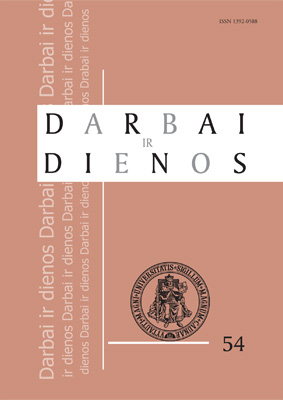Orthodox Christians as a Religious Minority in the Baltic States in The Interwar Period
Orthodox Christians as a Religious Minority in the Baltic States in The Interwar Period
Author(s): Sebastian RimestadSubject(s): Cultural Essay, Political Essay, Societal Essay
Published by: Vytauto Didžiojo Universitetas
Keywords: religija; religion; krikščionys ortodoksai; orthodox christians; interwar; tarpukaris; Baltic States; Baltijos valstybės
Summary/Abstract: Orthodox Christianity in Estonia, Latvia and Lithuania emerged, on the one hand, as a result of Russian migration to the area and mass conversion movements of the 19th century, on the other.1 These conversion movements had been most virulent among the Estonian peasantry while Lithuania had remained untouched. The development in the part of the Russian Orthodox Church that was situated outside the Soviet Union in 1920 was, with the exception of Lithuania, a movement towards ecclesial independence from Moscow. The leadership of the Estonian and Finnish part of the Church already in 1923 travelled to Constantinople (Istanbul) to plead for a release from the Patriarchate of Moscow and were granted an autonomous status within the jurisdiction of the Patriarchate of Constantinople. The Church in Poland followed suit two years later and the Latvian Church made the same move in 1935-6. The fact that they all, with the exception of the Church of Finland, became forcibly reintegrated into the Russian Orthodox Church during the Second World War need not interest us here. What is interesting is the way the Orthodox in the three Baltic States conceived of their place in the respective national society and its history. The rest of this paper focuses on how the national historiography of the Balts treated the Orthodox Churches and how the latter replied to this challenge. Baltijos šalyse – Estijoje, Latvijoje ir Lietuvoje – krikščionys ortodoksai sudaro religinę mažumą. XX amžiaus antrajame dešimtmetyje ši mažuma Estijoje sudarė 19 %, Latvijoje – 10 %, Lietuvoje – 1 % (be Vilniaus regiono). Baltijos valstybėse krikščionys ortodoksai laikyti carinės Rusijos reliktu. Pagrindinė stačiatikių problema Estijoje buvo ne tiek valstybės pripažinimas, kiek nuomonės apie juos, kaip naivius ir lengvai apgaunamus, paneigimas. Tautinėje istoriografijoje siekta keisti požiūrį į perėjimą į stačiatikių tikėjimą. Latvijoje, kur didžioji dalis stačiatikių buvo rusų tautybės, esminė problema – valstybės pripažinimas. Tai pavyko pasiekti tik baigiantis XX amžiaus trečiajam dešimtmečiui, įrodžius atsidavimą Latvijai ir latvių kalbai. Ypač daug prisidėjo arkivyskupas Jānis. Lietuvoje nebuvo poreikio tapti religine mažuma, nes visi stačiatikiai priklausė rusų ar baltarusių etninėms mažumoms.
Journal: Darbai ir dienos
- Issue Year: 2010
- Issue No: 54
- Page Range: 95-101
- Page Count: 7
- Language: English

